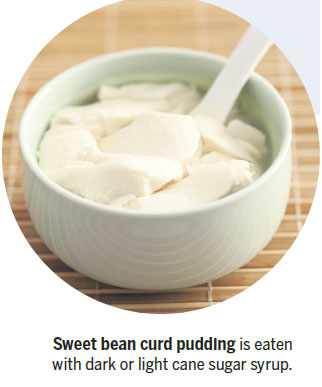Bean curd flowers or brains?
Editor's Note: China is divided into as many culinary regions as there are different ethnic groups. Its geographical diversity and kaleidoscopic cultural profiles contribute to the unending banquet of flavors.
The arguments start with the name. Most southern Chinese call this soft bean curd jelly douhua, or bean curd flower. Northerners, however, think it looks and tastes like soft-cooked offal, and it is known as doufunao, or bean curd brains.
The division is so wide that everything else about it comes under debate.
Should it be made with gypsum, brine or fermented vegetable juice? Should the texture be very soft or more solid? Should it be served in the morning or evening? Should it be served sweet or savory?
|
Soft bean curd jelly is good and easy to eat, for both toddlers and older people. Photos Provided to China Daily |
For 2,000 years now, the debate has gone on and on, and there are still people in China to this day who are fanatically loyal to sweet or savory and find the alternative hard to stomach.
Let's start at the beginning.
Bean curd itself was a serendipitous discovery when a group of Taoists seeking the elixir for immortality for an emperor dropped some liquid into a pot of soybean juice. It curdled and formed soft curds and tasted delicious. That was history.
Later, people learned to press the curds. Once the excess water was removed, a harder, cakelike texture resulted. This was the bean curd or tofu. From there, this product was made into puffs, deep-fried, stuffed, fermented and processed into a whole category of ingredients.
For many, it is the first soft curds that they love.
In the north, the bean curd jelly is breakfast food. Doufunao is sold in markets and outside train stations to cater to early-morning shoppers and commuters. It is savory and satisfying.
Vendors use a shallow ladle to skim scoops of bean curd pudding into a bowl, then add a thick brown sauce full of dried lily buds, black woodear mushrooms and tiny slivers of meat. Sometimes the gravy also has shreds of beaten egg.

The whole thing is garnished with chopped coriander.
According to my Beijing hutong-bred husband, the classic combination for breakfast in the old days, before Western fast food, was a bowl of doufunao, a dough fritter or youtiao, and shaobing, a baked pancake. This used to be sold mainly by Muslim vendors in his neighborhood, which was right next to Niu Jie, home to the oldest mosque in northern China. They would use mutton in the broth.
Nowadays, there is also a lighter version of doufunao, without the meat, but simply drizzled with thickened soy sauce, sesame oil and chili oil. Again, it is garnished with coriander.
Once breakfast is over, doufunao strangely disappears from Beijing streets, and it is not something you can order in restaurants, either.
In Zhejiang, they also like their bean curd jelly savory, pairing it with dried krill or tiny shrimps, chopped Sichuan pickled vegetables and spring onions.
In Sichuan itself, the excellent underground water makes the bean curd jelly exceptionally smooth and flavorful. The curds are eaten with the region's spicy sauces and roasted peanuts, or with deep-fried soybeans for that extra crunch.
Leshan in Sichuan, home to the giant Buddha carved out of the cliff-side, is famous for its douhua. There, the soybean juice is congealed with sweet potato starch and steamed with beef, and served with crispy dough fritters and meat fritters.
Douhua is so beloved in Sichuan that it is listed as one of the province's intangible cultural heritages.
The southerners in the provinces of Guangdong and Fujian also love their douhua, but they eat it all day long, for breakfast, lunch and dinner, in both sweet and savory ways.
For starters, the sweet bean curd pudding is eaten with dark or light cane sugar syrup. Sometimes, ginger juice is used to flavor the syrup.
It becomes an even more delicious dessert when sweetened red beans are added. In both Chaoshan and Fujian, ginkgo nuts and softened peanuts are some of the choices for toppings. There is even more variety at specialist stalls or shops that sell nothing but sweet bean curd jelly.
Douhua is easy to eat, for both toddlers and the toothless. It is easy to digest and doesn't tax the digestive system. A famous douhua dish is steamed with fish paste and goes by the name laoshao ping'an, peace for young and old.
In Chinese supermarkets these days, you can buy bean curd making sets, with the soybean powder and a bottle of congealant.
The use of gypsum is largely frowned upon these days, and it's hard to find the other "sour water" congealant made of fermented amaranth roots. Instead, most prefer to use a sea-salt brine.

These are available in little bottles with eyedrop dispensers. Some of the best are the Japanese brine from Hokkaido, if you would like to make your own.
To me, bean curd jelly is the ultimate comfort food.
My fondest memories are of those dark, damp winter nights in Hong Kong, getting off the bus after work after midnight and waiting in line for a bowl of steaming hot bean curd jelly. The old lady only had a single pot, which she'd carry at the end of a bamboo pole. On the other end would be a huge vat of dark sugar syrup strongly flavored with grated ginger.
You stood on the sidewalk slurping up the bean curd with a metal Chinese spoon, each mouthful gliding down the throat and into the stomach, the warmth spreading out like the rays of an internal sun.
Too soon, you handed back the empty bowl and watched as she packed up, before slowly walking off, her shadow shimmering as she passed the rain puddles on the road.
paulined@chinadaily.com.cn
Steamed Bean Curd Pudding
This was my Cantonese grandmother's recipe.
A large bowl of plain bean curd jelly, unsweetened
300g shrimps, shelled and deveined
Chopped spring onions
Soy sauce, sesame oil
You can buy a bowl of plain bean curd jelly from your market vendor for this dish. Alternatively, you can use a tub of soft silken tofu, which is firmer but works just as well.
Prepare the shrimps by rinsing them and then drying them thoroughly on kitchen paper towels. This is to keep them crisp. If you have time, place them in the refrigerator, uncovered, to dry off even more.
Place the bean curd in a large soup bowl and add the shrimps on top. Steam over high heat for 5 to 6 minutes. Remove from heat and season with soy sauce and sesame oil. Sprinkle with spring onions.
Nothing can be simpler. It's a good dish to serve for lunch on hot summer days.
(China Daily European Weekly 08/04/2017 page18)























